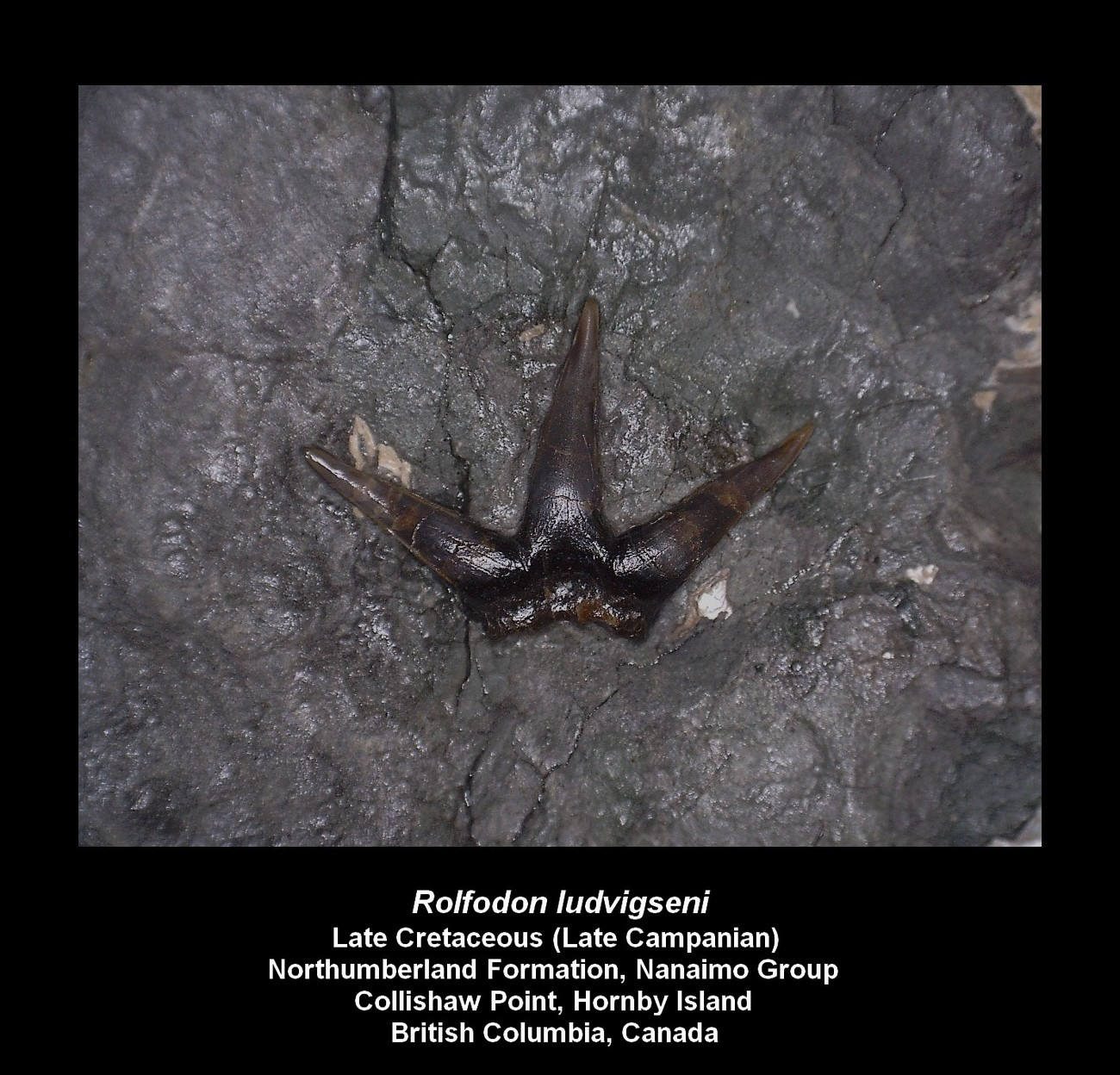Rolfodon ludvigseni
Cappetta, Morrison & Adnet, 2019
Classification: Elasmobranchii Hexanchiformes Chlamydoselachidae
Reference of the original description
A shark fauna from the Campanian of Hornby Island, British Columbia, Canada: an insight into the diversity of Cretaceous deep-water assemblages. Historical Biology, 33(8), 1121–1182
A shark fauna from the Campanian of Hornby Island, British Columbia, Canada: an insight into the diversity of Cretaceous deep-water assemblages. Historical Biology, 33(8), 1121–1182
Types
Rolfodon ludvigseni
Rolfodon ludvigseni
Description:
Citation: Rolfodon ludvigseni Cappetta, Morrison & Adnet, 2019: In: Database of fossil elasmobranch teeth www.shark-references.com, World Wide Web electronic publication, Version 04/2024
Please send your images of "Rolfodon ludvigseni" to info@shark-references.com

Rolfodon ludvigseni Cappetta, Morrison & Adnet, 2019, Late Cretaceous, Late Campanian, Northumberland Formation, Nanalmo Group, Collishaw Point, Hornby Island, Canada. Collection and © Adam Anderson

Rolfodon ludvigseni Cappetta, Morrison & Adnet, 2019, Late Cretaceous, Late Campanian, Northumberland Formation, Nanalmo Group, Collishaw Point, Hornby Island, Canada. Collection and © Adam Anderson
Description
Original diagnosis after Cappetta, Morrison & Adnet, 2019 [27810]: Same diagnosis as the genus Rolfodon nov. gen. The species R. ludvigseni nov. sp. differs from the contemporary coeval R. thomsoni and R. goliath by its cusps being less broad and stout, with less salient cutting edges, and by the cusps enameloid, smooth or with short basal labial folds in some specimens. Moreover, the lingual faces of the cusps of R. ludvigseni nov. sp. being smooth contrast with those of R. thomsoni, which are strongly folded.
Diagnosis Rolfodon: This chlamydoselachid genus is mainly characterised by a thick root longer than broad bearing a pair of lingual crests labio-lingually oriented. The crown consists of three cusps, an erect central one with a pair of diverging lateral ones. In profile view, the cusps are slightly bent lingually. The enameloid of the cusps can be strongly folded like in the type species, or bear some short labial folds at the base of the cusps, or even be completely smooth. A pair of marginal small sharp and hooked cusplets can occur in some specimens. The basal face of the root is slightly concave and devoid of any groove. However, foramina can be observed in some specimens. Rolfodon nov. gen. can be distinguished from Chlamydoselachus by more erect cusps in profile view, by a pair of lingual crests labiolingually oriented on the root, and by a root broader than long with a transversely concave basal face. Rolfodon nov.gen. differentiates from Dykeius nov. gen. by its much smaller teeth, having shorter straighter cusps and by a root longer than broad compared to Dykeius nov. gen. which has a far broader than long root.
Original diagnosis after Cappetta, Morrison & Adnet, 2019 [27810]: Same diagnosis as the genus Rolfodon nov. gen. The species R. ludvigseni nov. sp. differs from the contemporary coeval R. thomsoni and R. goliath by its cusps being less broad and stout, with less salient cutting edges, and by the cusps enameloid, smooth or with short basal labial folds in some specimens. Moreover, the lingual faces of the cusps of R. ludvigseni nov. sp. being smooth contrast with those of R. thomsoni, which are strongly folded.
Diagnosis Rolfodon: This chlamydoselachid genus is mainly characterised by a thick root longer than broad bearing a pair of lingual crests labio-lingually oriented. The crown consists of three cusps, an erect central one with a pair of diverging lateral ones. In profile view, the cusps are slightly bent lingually. The enameloid of the cusps can be strongly folded like in the type species, or bear some short labial folds at the base of the cusps, or even be completely smooth. A pair of marginal small sharp and hooked cusplets can occur in some specimens. The basal face of the root is slightly concave and devoid of any groove. However, foramina can be observed in some specimens. Rolfodon nov. gen. can be distinguished from Chlamydoselachus by more erect cusps in profile view, by a pair of lingual crests labiolingually oriented on the root, and by a root broader than long with a transversely concave basal face. Rolfodon nov.gen. differentiates from Dykeius nov. gen. by its much smaller teeth, having shorter straighter cusps and by a root longer than broad compared to Dykeius nov. gen. which has a far broader than long root.
References

Global impact and selectivity of the Cretaceous-Paleogene mass extinction among sharks, skates, and rays. Science, 379, 802–806
DOI: 10.1126/science.abn2080

A shark fauna from the Campanian of Hornby Island, British Columbia, Canada: an insight into the diversity of Cretaceous deep-water assemblages. Historical Biology, 33(8), 1121–1182
DOI: 10.1080/08912963.2019.1681421

Global impact and selectivity of the Cretaceous-Paleogene mass extinction among sharks, skates, and rays. Science, 379, 802–806
DOI: 10.1126/science.abn2080

A shark fauna from the Campanian of Hornby Island, British Columbia, Canada: an insight into the diversity of Cretaceous deep-water assemblages. Historical Biology, 33(8), 1121–1182
DOI: 10.1080/08912963.2019.1681421















